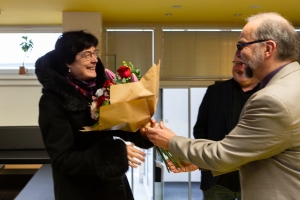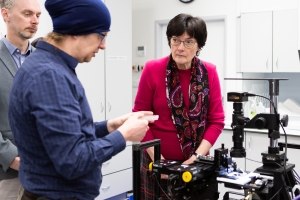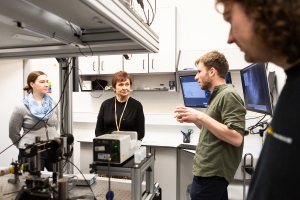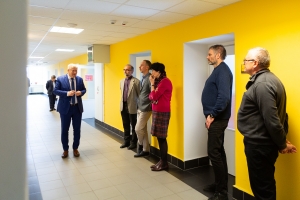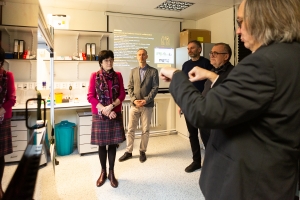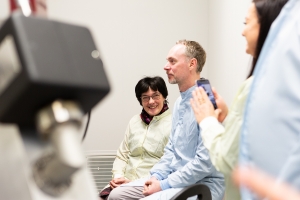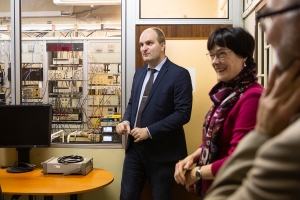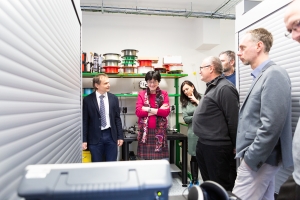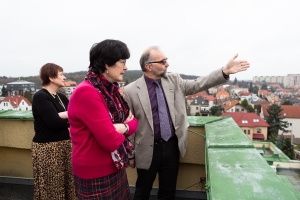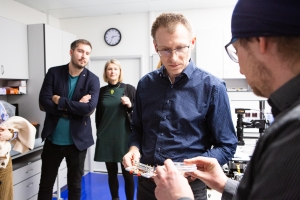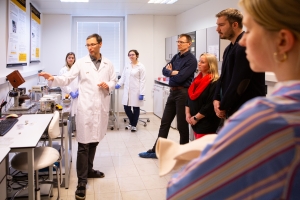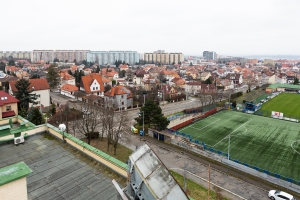During her visit to the Institute of Photonics and Electronics on 28 February, the President of the Cezch Academy of Sciences Eva Zažímalová together with Vice-President Ilona Müllerová and their colleagues, visited seven laboratories in the building in Kobylisy.
At the Bioelectrodynamics research team's lab, Michal Cifra presented research on the interaction of electromagnetic fields with organisms at the cellular and molecular level for new approaches in nanotechnology and also new and especially non-invasive approaches in biomedical diagnostics and therapy. The tour continued to two other laboratories where Jiří Homola and his colleagues presented research on optical biosensors based on surface plasmons resonance. The next stop was the laboratory of Marek Piliarik's nano-optics team, which recently received the Academy of Sciences award for outstanding achievements in research, experimental development and innovation. In the nanolab, Stanislav Tiagulskyi from Jan Grym's Synthesis and characterization of nanomaterials research team demonstrated to Academy management how zinc oxide rods are characterized using an electron microscope.
In the Laboratory of the National Time and Frequency Standard Alexander Kuna presented the national time scale UTC(TP), Universale tempus coordinatum - Tempus Pragense. In Pavel Honzátko laboratory of Fiber lasers and nonlinear optics, great interest was attracted by a practical demonstration of how optical fibers of a typical local-area computer network make it possible to eavesdrop on conversations in individual rooms of a building. As part of a project of the security research program of the Ministry of the Interior, we are investigating new types of hollow-core optical fibers that suppress the risk of eavesdropping.
The management of the Czech Academy of Sciences also climbed the UFE tower, the highest point in the Institute, from which one can get a good view of the entire UFE campus in Kobylisy. At the same time, it offers a truly unusual view of our metropolis, especially of the adjacent housing estates of Ďáblice and Kobylisy and the picturesque "garden city" so typical of the urban development of Prague in Masaryk's First Republic. The nearby campus of the Czech Academy of Sciences at the Ládví metro station is also visible.
The management of the Academy of Sciences appreciated the cutting-edge research supported by the prestigious projects of the Jan Amos Komenský Operational Programme (we wrote here), EXPRO projects of the Czech Science Foundation, European and other projects, as well as the growing successful commercialisation of some research outputs. Particularly interesting was the leading national role of ÚFE at research on lasers for defence, e.g. in the framework of the European Defence Agency's anti-drone system project (we wrote here).
"We are happy we build on the past successes of the Institute and to fulfil the mission of our Institute in both basic and applied research: that the joint work of all of us at the ÚFE contributes to satisfying the eternal human desire for knowledge (in our case in the fields of photonics and electronics) and that we contribute to the technological development of Czech industry," said Director Pavel Peterka in conclusion.
On Thursday afternoon, March 14, we welcomed the Director of the Office of the Czech Academy of Sciences, Leoš Horníček, and his team of close associates. The guests visited selected laboratories of our institute and climbed to the highest point of the ÚFE building - the tower. For both parties, this personal visit was a valuable opportunity to discuss administrative and technical issues related to the operation of the Institute and to see the fruits of their work on the spot.
Photo by: Petra Palečková


